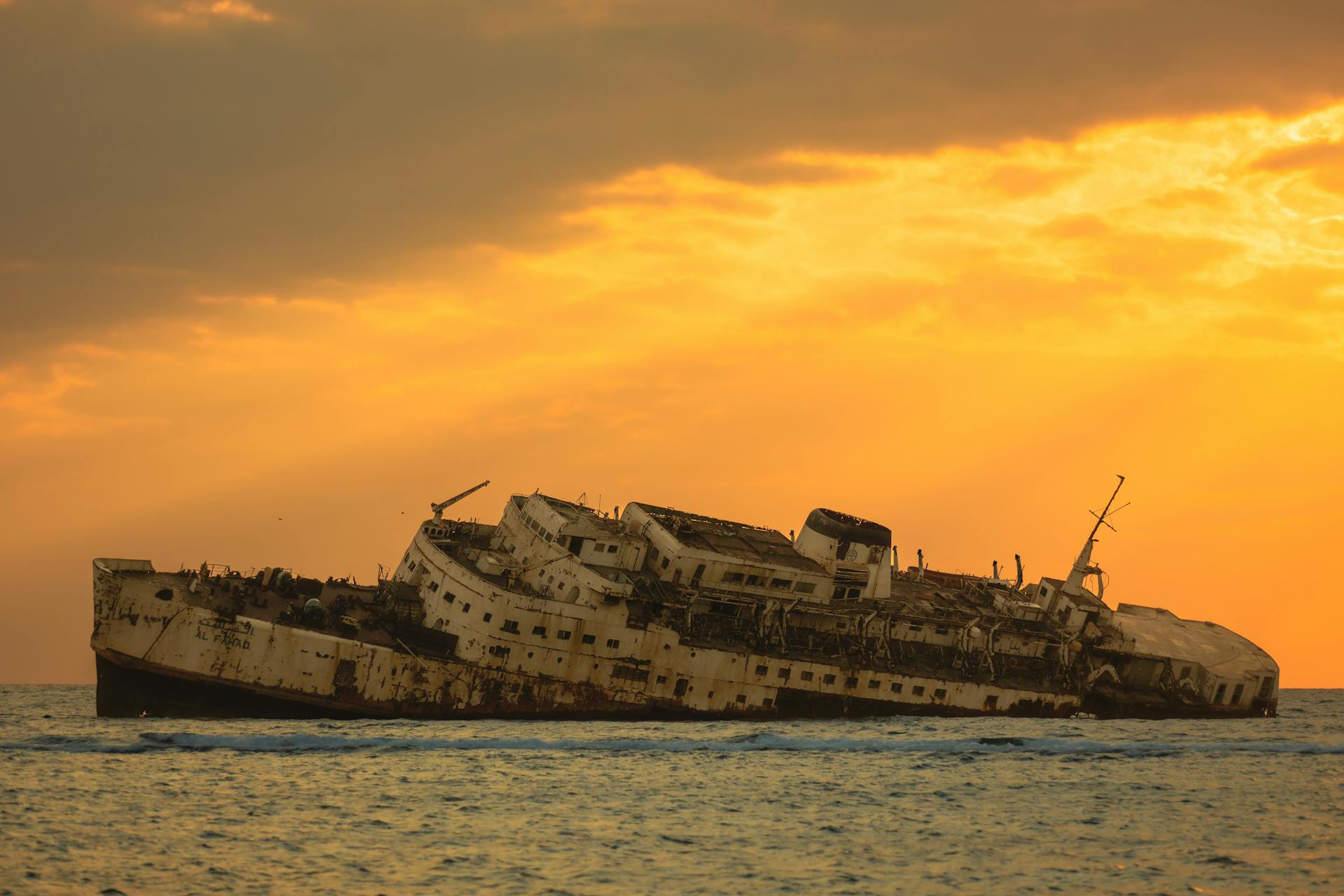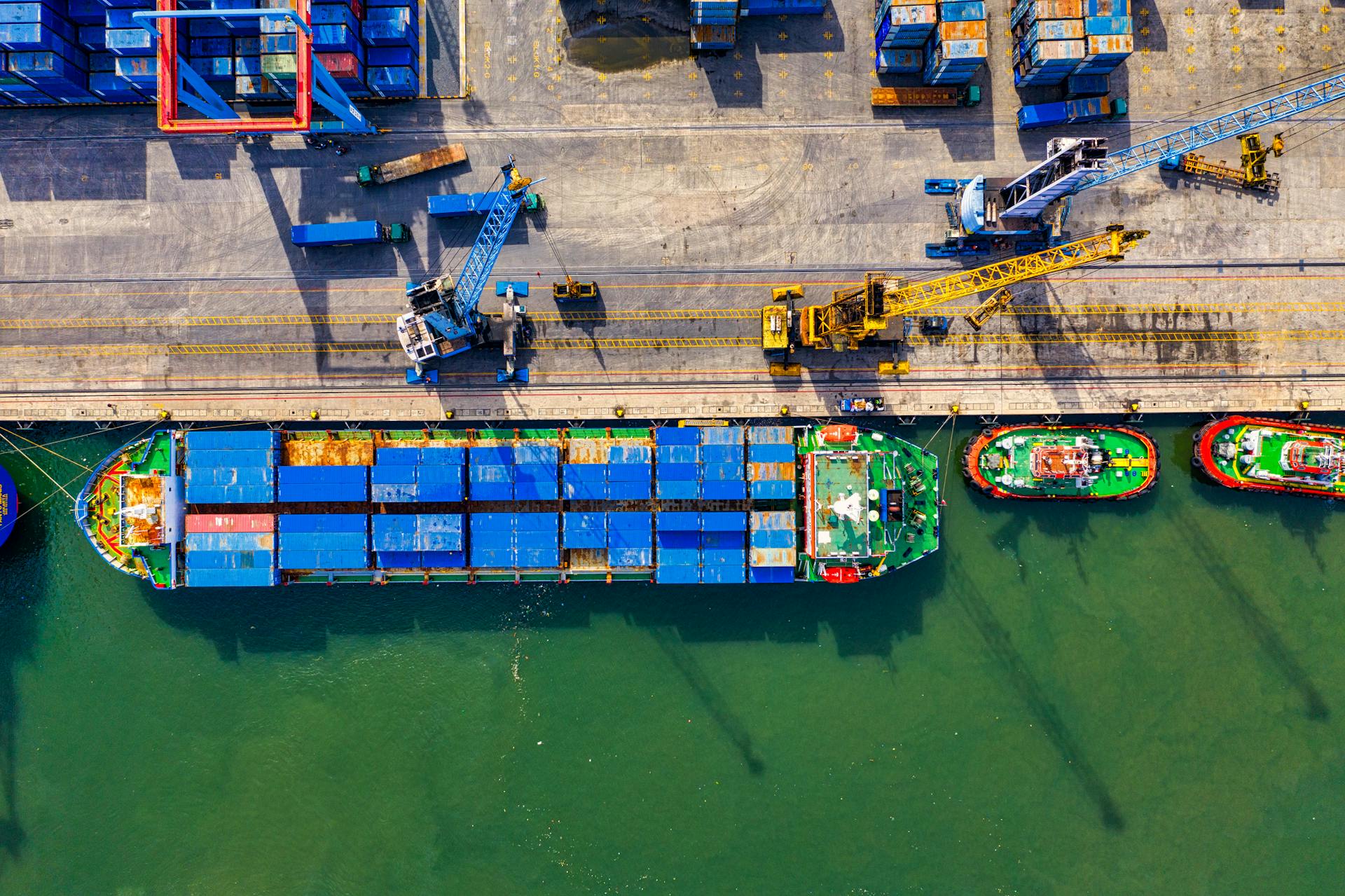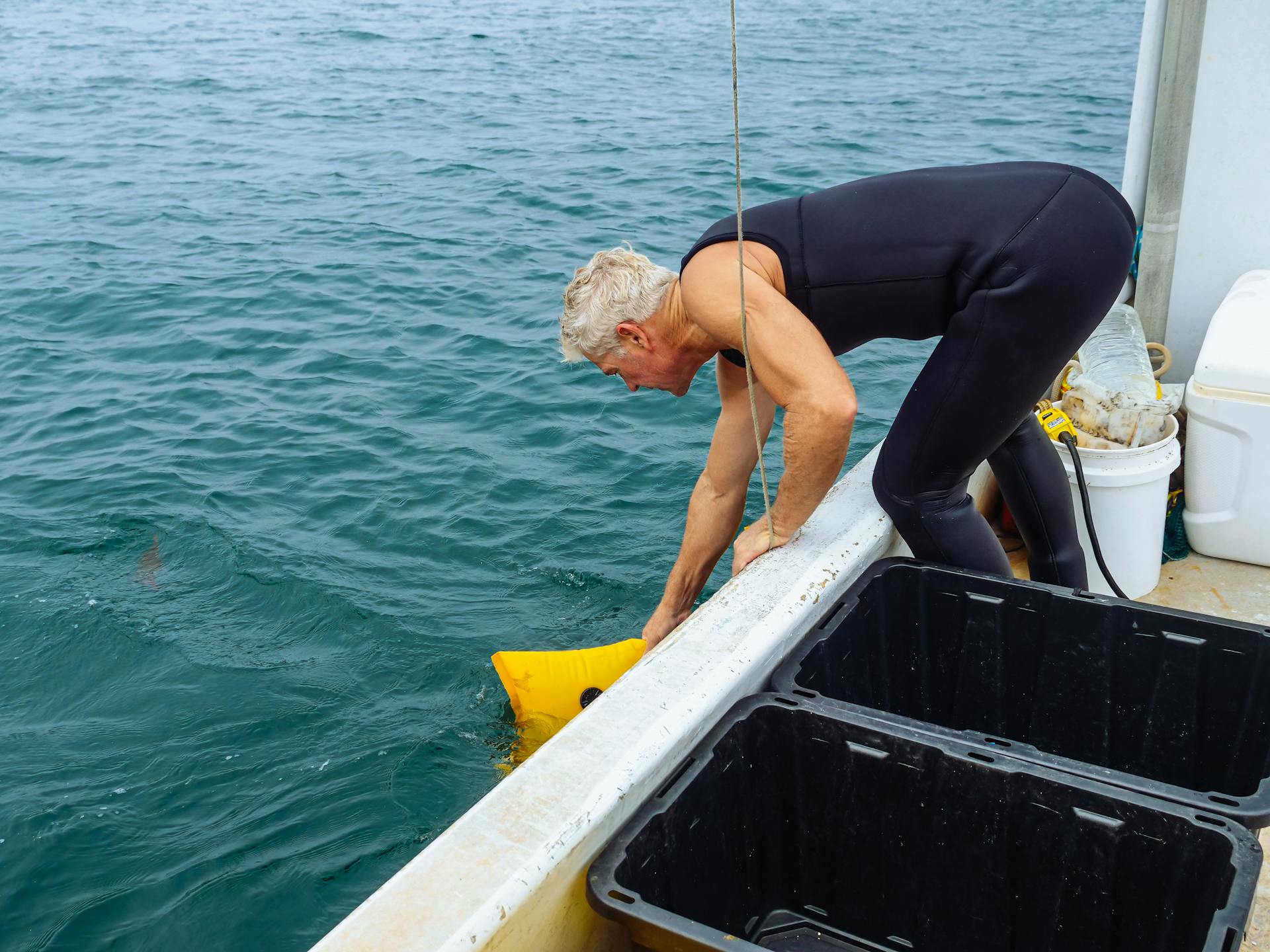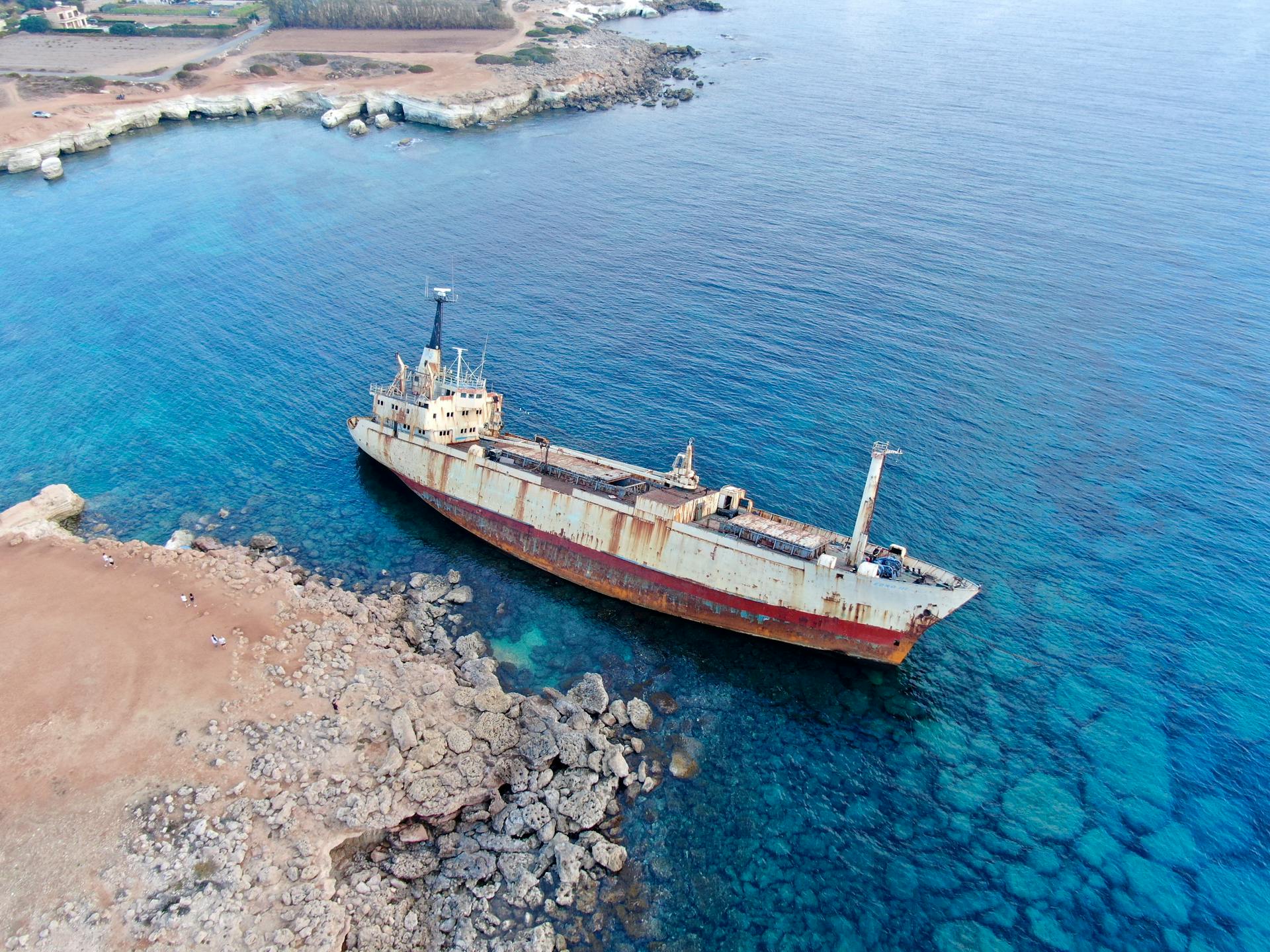
The MV Rena maritime disaster was a devastating event that occurred on October 5, 2011, off the coast of New Zealand. The ship ran aground on a coral reef.
The MV Rena was a container ship that was traveling from Napier to Tauranga when it lost control and drifted onto the reef. It was carrying a cargo of containers and vehicles.
The ship's cargo included 1,500 containers, 47 of which were carrying hazardous materials. The ship's crew was rescued, but the vessel itself was badly damaged.
Discover more: Cargo Ship Container
The Accident
The MV Rena was a Liberian-flagged container ship that grounded on the Astrolabe Reef off the coast of Tauranga, New Zealand.
It happened in the early hours of the morning on October 5, 2011, with 1,368 containers onboard.
The ship was carrying a capacity of 3,500 TEU and had a weight of 47,230 DWT.
The grounding occurred north of New Zealand, about twenty kilometres off the coast of Tauranga, a port that's specialized in wood export.

The ship was on its way from Napier to Tauranga when it ran aground.
A second grounding occurred in the same region on October 28, 2011, involving the container ship Schelde Trader, but it didn't have any major consequences.
The Rena was carrying hazardous materials and large amounts of oil, which would later lead to a significant environmental disaster.
Response and Cleanup
The response to the MV Rena oil spill was swift, with the first slicks observed on October 6 and dispersant spraying operations starting the next day.
The starboard tank was pierced, releasing pollutant that proved difficult to clean up.
Maritime New Zealand declared the accident a Tier 3 emergency, the highest level of pollution risk, and set up an Incident Coordination Centre with 200 people to oversee the response.
Experts from the UK, Australia, and Singapore arrived on site to provide technical advice, and New Zealand Defence Force personnel and vessels assisted with pollutant recovery operations.

Pollutant recovery operations began at sea on October 9, but proved to be of limited efficiency due to the pollutant's rapid thickening in the temperature conditions.
The Rena's captain was arrested on October 12, and his second officer the following day, charged with operating the vessel in a manner causing unnecessary danger or risk.
Cleanup efforts took time, with petroleum oil naturally breaking down over time with oxygenation.
The oil dispersant Corexit 9500 was used to help in the cleanup process, but it was only applied for a week due to inconclusive results.
Rena ship owners spent NZD235 million on salvage and cleanup operations, and insurance costs for removal of the wreck were estimated at US$240 million.
By December 2020, nature had begun to recover the wreck, with divers discovering a thriving kelp forest.
For more insights, see: Mv Derbyshire Wreck
Environmental Impact
The environmental impact of the MV Rena disaster was severe. Over 2,000 dead birds were found by November 22nd, with many more likely affected.
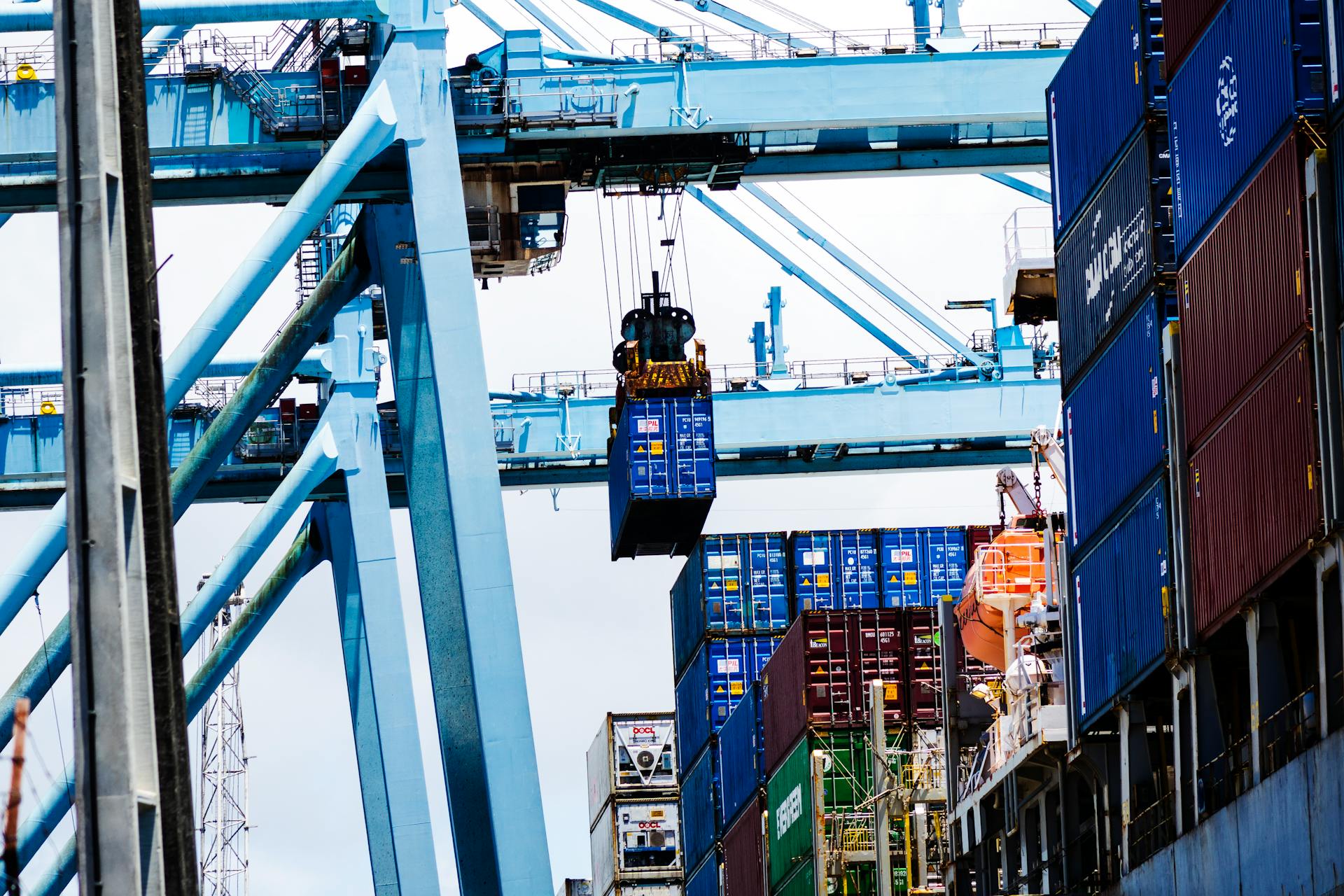
The Rena pollution also had a devastating effect on local wildlife. Dolphins, whales, seals, and penguins were among the species impacted.
Scientific studies are currently underway to assess the full extent of the damage. This will help inform strategies for preventing similar disasters in the future.
A list of notable oil spills can be found below, highlighting the risks and consequences of such events.
Wreck Management
The Rena's wreck management was a complex and challenging process. A salvage plan was prepared by Svitzer's Dutch naval architects, based on the ship's resistance calculations.
Motion sensors were fitted to the vessel to monitor its stability and measure hull movements, which helped the team understand the ship's behavior during the salvage operation.
A storm on October 10 made response operations very difficult, causing a large crack to form on the port side of the vessel, putting the hull at risk of breaking in two.
Discover more: MS Pride of Hull
Salvage Teams
Salvage teams play a crucial role in wreck management, and it's essential to understand their capabilities and limitations.
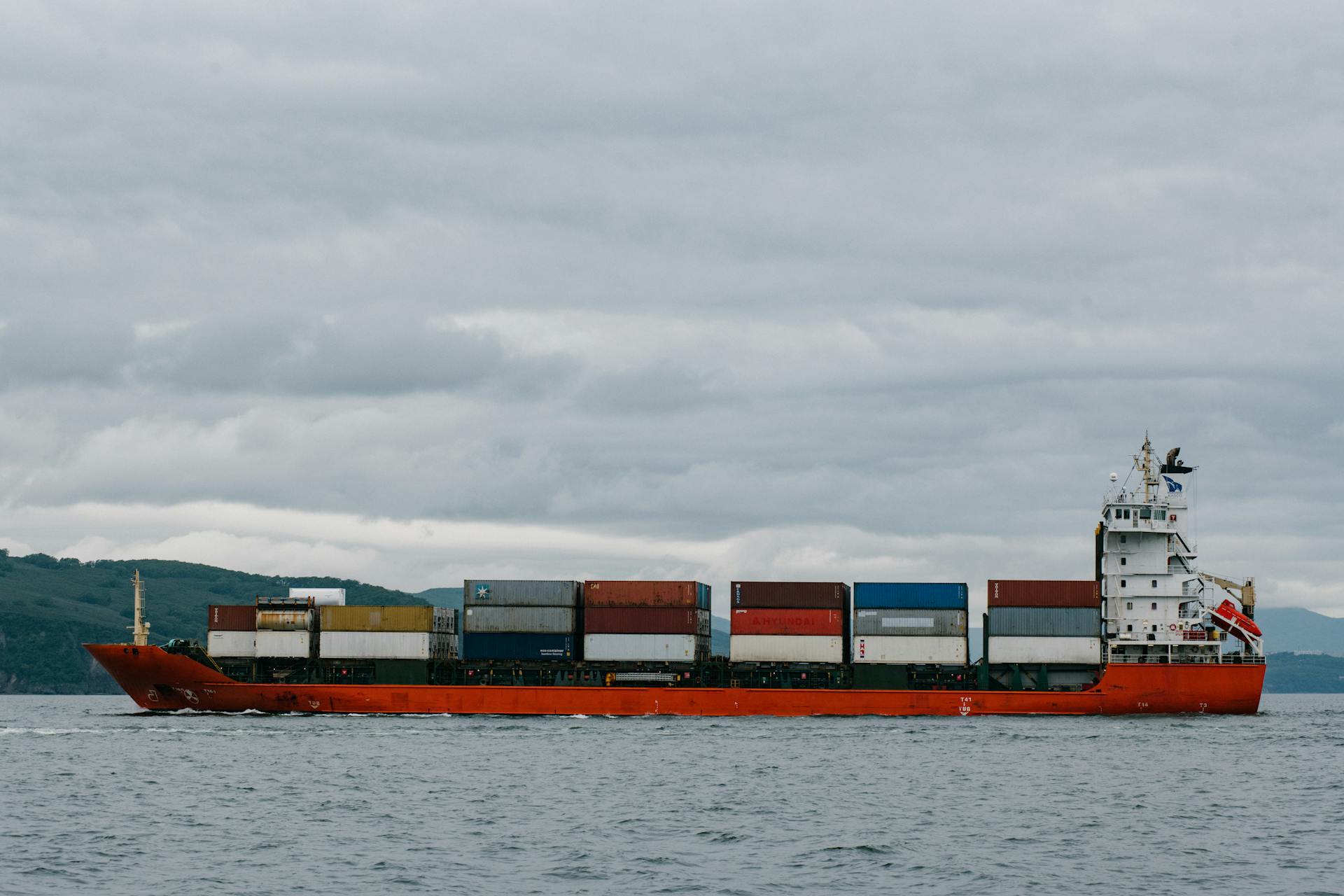
In 2011, there were approximately 400 trained responders to oil spills in the country, but most of them had received low-level training.
Only 60 of the 400 trained responders had achieved high-level training, highlighting a need for improved training standards.
A salvage company named Svitzer was hired to assess the safety of contracted salvage teams on the ship and to continue salvage procedures.
The key tasks carried out by the salvage teams included removal of oil from the ship through a transferring process and collection of released containers and other waste.
Salvage teams were helicoptered onto the ship, as that was advised as the safest way to access the wreck.
The Marine Pollution Response Service suggested that a higher level of training was required in various levels of response training, and there was a report of insufficient development in the information and training given to salvage teams.
You might enjoy: Russian Training Ship Smolnyy
Wreck Management
Wreck management is a complex process that requires careful planning and execution.

In the case of the Rena, a salvage plan was prepared by Svitzer's Dutch naval architects, based on the ship’s resistance calculations. This plan helped the team to understand the vessel's stability and movements.
Motion sensors were fitted to the vessel to monitor its stability and measure hull movements. This allowed the team to stay on top of the situation and make adjustments as needed.
A storm made response operations very difficult on 10 October, causing a large crack to form on the port side of the vessel. The hull was at risk of breaking in two, and the crew were evacuated.
The Rena cracked and partially broke in two on 1st January 2012, due to adverse weather conditions on site. The wreck’s situation remained stable for a week, during which container removal operations continued.
300 of the 800 containers remaining onboard at the time fell overboard, containing powdered milk and timber among other things. A 3 nautical mile exclusion zone was put in place around the wreck due to the high collision risk caused by the presence of containers and debris at sea.
A fresh viewpoint: Stowage Plan for Container Ships
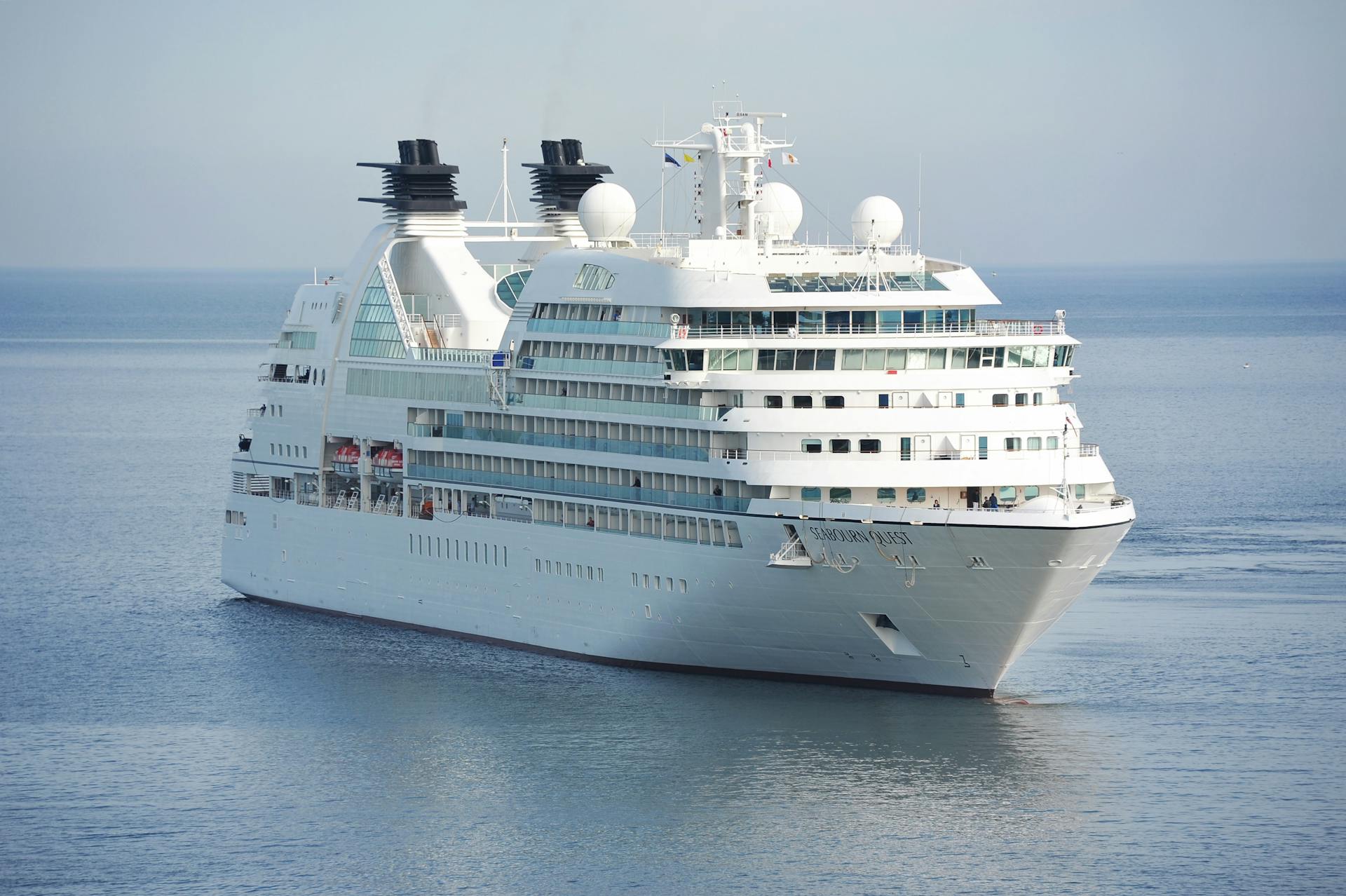
The oil pollution risk remained present with around 350 tonnes of fuel oil remaining in the Rena’s tanks. A new aerial surveillance campaign was set up to monitor the situation.
During wreck dismantling operations in September 2012, 430 tonnes of steel from the bow were evacuated by helicopter. Operations to cut up the submerged part of the vessel by 2 teams of divers began in the following weeks.
Cargo and Ship
The MV Rena was carrying a massive 1,700 tonnes of oil, including heavy fuel oil and engine oil, which posed a significant risk of pollution in the Bay of Plenty, a popular tourist destination.
The cargo also included 1,368 containers, with 32 containing hazardous substances and 121 containing perishable foodstuffs. This highlights the importance of proper cargo handling and storage.
Some of the hazardous substances transported on board included ferrosilicon, alkyl sulfonic acid, hydrogen peroxide, potassium nitrate, and trichloroisocyanuric acid.
Here's a breakdown of some of the hazardous substances transported on board:
Oil Pumping and Container Recovery

Oil pumping and container recovery operations are a crucial part of cargo and ship management, as we saw in the case of the Rena vessel.
Salvage teams had to inject water and use booster pumps to remove the viscous fuel oil from the vessel's tanks, which was a challenging task.
A total of 319 tonnes of fuel oil were collected on 13 November 2011, leaving only 60 tonnes remaining in the number 5 starboard tank.
The removal of containers from the rear deck of the vessel was a tricky operation, with experts estimating that 6 containers could be removed per day.
In total, 1,007 containers were recovered from the vessel, which is a significant number considering the estimated 1,280 containers that remained on board.
The containers were equipped with locater beacons, known as 'pingers', to make them easier to detect if they fell overboard.
Nature of the Cargo
The cargo on board the Rena was a mix of oil, hazardous substances, and perishable foodstuffs. A total of 1,700 tonnes of oil, including heavy fuel oil and engine oil, was at risk of being released into the Bay of Plenty.
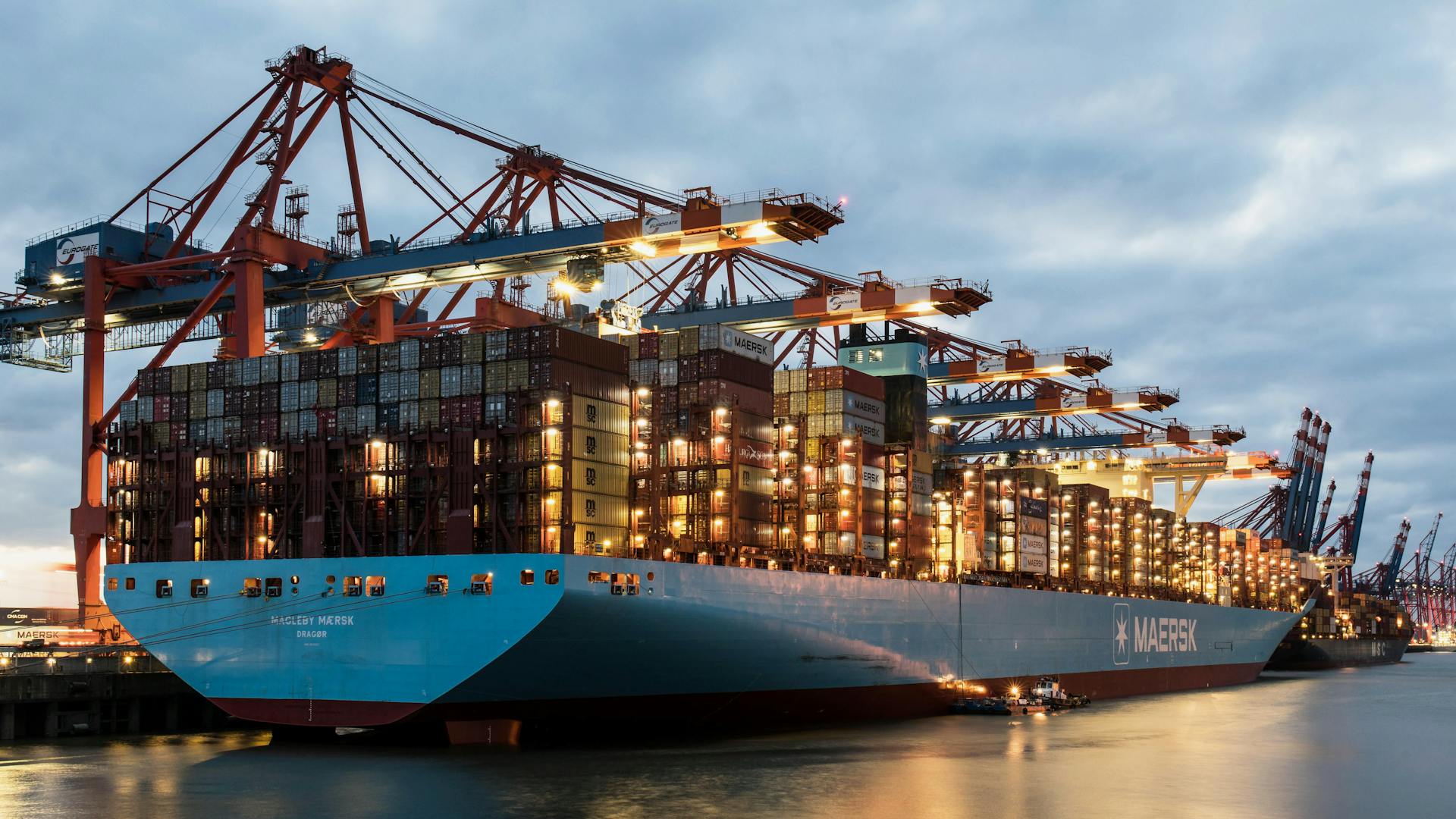
The container ship was carrying 1,368 containers in total, with 547 on deck and 821 below deck. This is a significant number of containers, highlighting the importance of proper cargo handling and storage.
Among the containers, 32 contained hazardous substances, including alkyl sulfonic acid. This is a serious concern, as hazardous substances can pose a significant risk to the environment and human health.
The Rena was also carrying 121 containers of perishable foodstuffs, which adds to the complexity of the situation. Perishable goods require special handling and storage to maintain their quality and safety.
A total of 169 containers fell overboard during the incident, with 53 identified so far. This is a concerning number, and the search for the remaining missing containers is still underway.
Here is a list of the potentially hazardous substances transported on board the Rena:
Cargo Ship Breaks Up Off NZ
A cargo ship breaking up off the coast of New Zealand is a serious incident that highlights the importance of cargo ship safety.
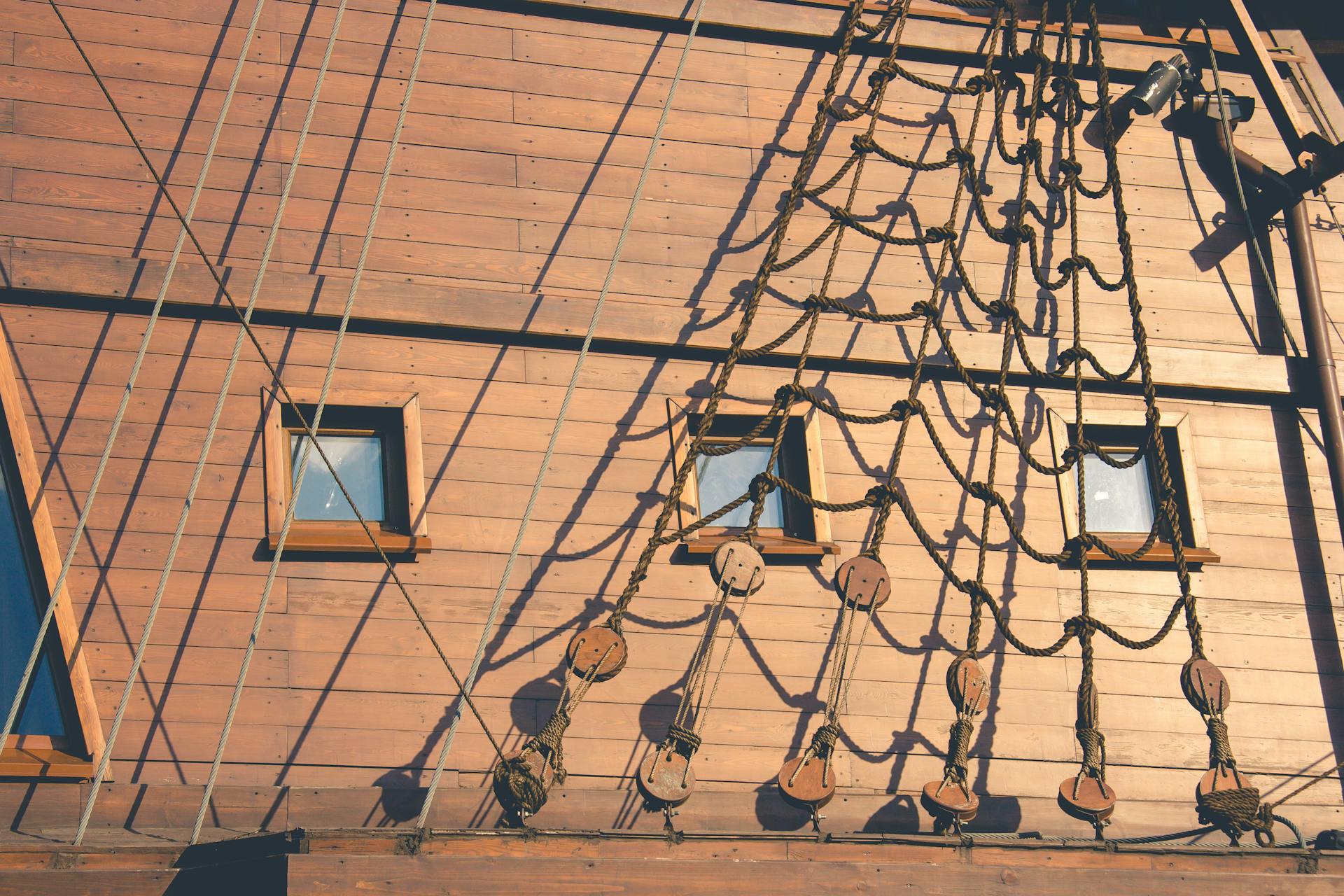
The MV Rena, a container ship, ran aground off the coast of Tauranga in 2011 and broke up, releasing over 350 tons of oil into the ocean.
This incident resulted in significant environmental damage and a major cleanup operation.
The ship was carrying a cargo of containers, including cars and machinery.
The MV Rena was a Panamax-class ship, measuring 236 meters in length and 32 meters in width.
It was built in 2005 and had a gross tonnage of 22,890 tons.
Responsibilities and Reactions
The captain and navigation officer of the Rena pleaded guilty to operating a ship in a dangerous manner, releasing toxic substances, and attempting to pervert the course of justice. They were sentenced to 7 months imprisonment.
The owner of the Rena was fined NZ$300,000 for releasing hazardous substances and an additional NZ$10,000 for every day the pollution continued. MSC, the Rena's charterer, made a NZ$1 million "voluntary donation" to cover some of the costs related to the incident.
Responsibilities
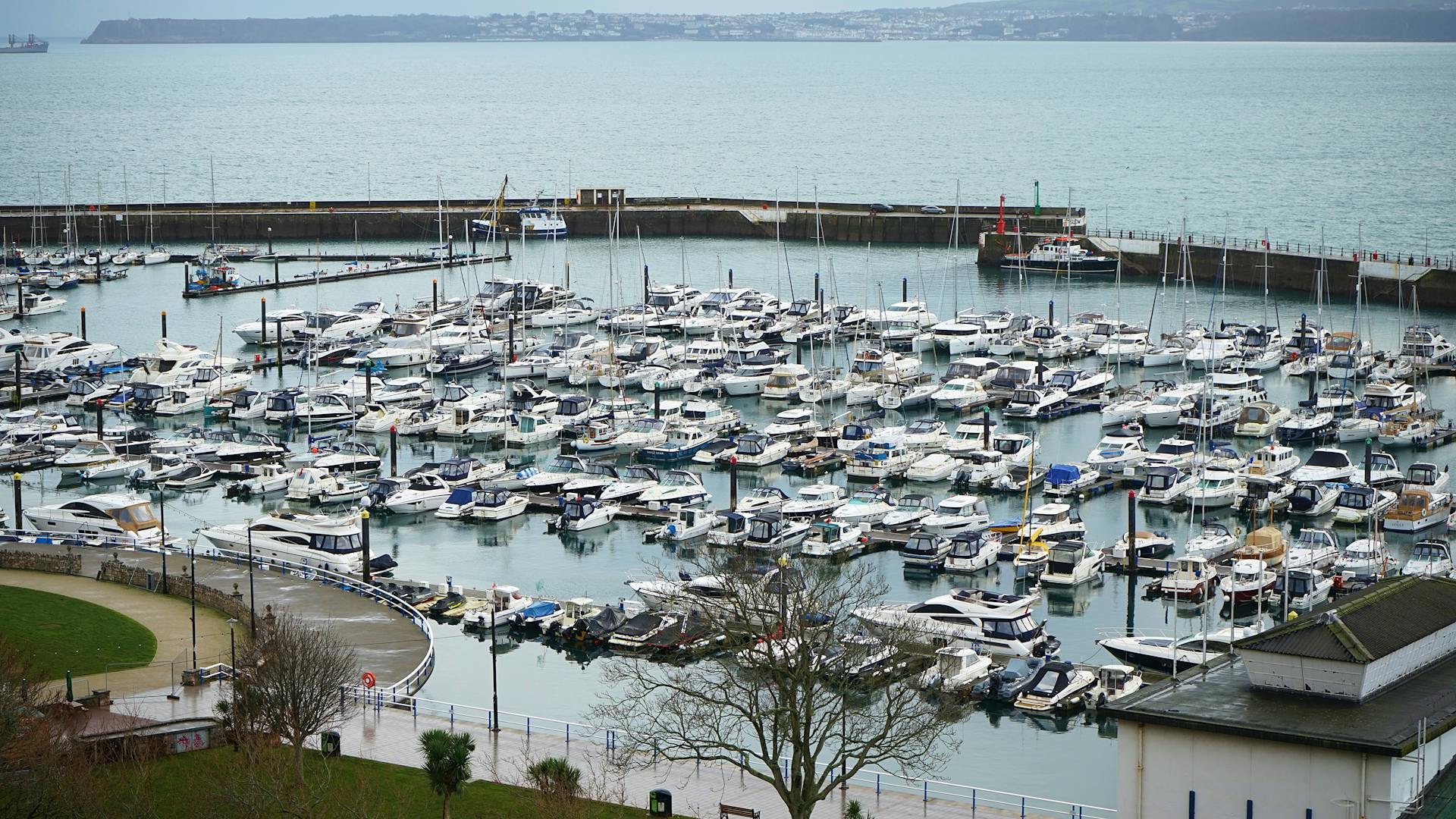
The Rena's charterer, MSC, made a NZ$1 million "voluntary donation" to help with the costs related to the incident.
The Swedish P&I Club, which insures Costamare, indicated that it would cover all costs related to the incident, including those related to pollution.
The captain and navigation officer of the Rena pleaded guilty to operating a ship in a dangerous manner, releasing toxic substances, and attempting to pervert the course of justice.
They were sentenced to 7 months imprisonment.
The owner was fined NZ$300,000 for releasing hazardous substances and an additional NZ$10,000 for every day the pollution continues.
The captain and second officer were found guilty of a total of eleven charges and each was sentenced to seven months in jail.
Media Coverage and Reactions
The media coverage of the oil spill was initially slow to pick up, partly due to the death of Steve Jobs on the same day.
The incident didn't surface on major news websites until four days later, when CBC News published an article on October 9, 2011.
Here's an interesting read: Austal Ships News

Residents of Motiti Island were concerned about the effects of the oil spill on their lives, as they relied on water and seafood from the affected waters for survival.
The cost of leaving the island for food or water was around $100, making it a significant burden for the islanders.
New Zealand environmental minister, Nick Smith, described the impact of the spill as the most significant in New Zealand history.
The spill's potential to harm the pristine waters of the Bay of Plenty was also a concern, as World Wildlife Fund spokesperson Bob Zuur confirmed a major loss of wildlife.
Sequence of Events
The MV Rena was a container ship that ran aground off the coast of New Zealand in 2011.
On October 5, 2011, the ship was traveling from Napier to Tauranga when it encountered strong winds and heavy rain.
The ship's crew attempted to navigate through the rough seas but failed to notice a shallow sandbar.

The Rena grounded on the sandbar at around 2:00 am, causing significant damage to the ship's hull.
The ship's cargo, including containers of oil, fertilizers, and other hazardous materials, was at risk of spilling into the ocean.
The crew sent out a distress signal and the Coastguard was alerted to the situation.
The Coastguard and other emergency responders quickly arrived on the scene to assess the situation.
The ship's crew was forced to evacuate the vessel due to the severity of the damage.
The Rena remained stuck on the sandbar for several days, with oil and other pollutants leaking into the ocean.
The incident was later determined to be caused by a combination of factors, including the ship's poor navigation and the crew's failure to notice the shallow sandbar.
Readers also liked: El Faro Ship Crew
Frequently Asked Questions
Who was the captain of MV Rena accident?
The captain of the MV Rena was Captain Mauro Balomaga. He was identified after having his name suppression lifted following the 2011 shipwreck.
How much oil did the Rena spill?
The Rena ship spilled approximately 400 tons of oil into the water. This environmental disaster required a significant cleanup effort by Costamare and the New Zealand government.
Sources
- https://en.wikipedia.org/wiki/MV_Rena
- https://wwz.cedre.fr/en/Resources/Spills/Spills/Rena
- https://en.wikipedia.org/wiki/Rena_oil_spill
- https://www.theguardian.com/world/2012/jan/08/cargo-ship-rena-breaks-new-zealand
- https://www.oldsaltblog.com/2012/05/update-mv-rena-cover-up-revealed-and-jail-time-for-captain-and-second-officer/
Featured Images: pexels.com
